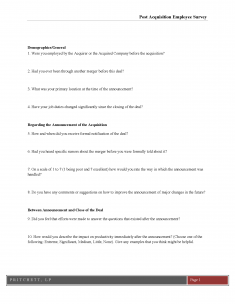Upon announcement, let employees clearly know:
- The reasons behind the combination
- Specifics of the agreement
- What the company and its people will gain or lose
- How the company will proceed with integration and change
- General facts about the partners–size, products, history, key executives, and locations
- How business should be conducted during the transition period
- Immediate implications for job security
- What to say to customers and clients
- Changes in policy or procedures
If known, information can also be communicated regarding:
- Changes in company name and logo
- Changes in organizational structure and management positions
- Whether or not there will be any reductions in force, facility closings, divestitures, or outsourcing
- Changes in product lines and marketing strategy
- Areas of integration or reorganization
- Changes in compensation and benefits
Even if plans are not finalized, people can still be told:
- Who will be making the decisions
- When decisions are expected (not promised) to be made
- How both sides will be involved in making the decisions
- The criteria to be used in decision making
As integration decisions are made, communicate information regarding:
- Changes in organizational mission and strategy
- Changes in organizational structure and systems
- Changes in management and reporting relationships
- Changes in job titles and job descriptions
- New career paths and opportunities
- Changes in procedures, policies, forms, and systems
- Staff reductions and/or reassignments
- Layoffs and provisions for job loss (e.g. severance pay, outplacement, hiring freeze, and so forth)
- The rationale for all of the above





